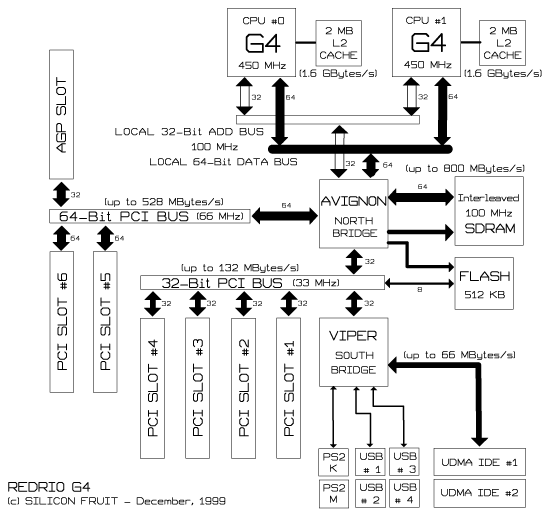In
the mid-90ís there was a promising movement for a new open computer architecture
called the Common Hardware Reference Platform (CHRP) that utilized the IBM/Motorola
PowerPC processor. Originally, the platform was to be able to run the Mac OS,
Windows NT, Solaris, OS/2, and AIX. Also, the design was to be used with existing
IBM-compatible peripherals, and some designs were shown with parallel and PS/2
ports. The name of CHRP was then officially changed to the more identifiable PowerPC
Platform moniker in 1996.
The
idea of the PowerPC Platform was exciting for many people, especially the Mac
users, as the platform promised lower hardware prices and more flexibility. However,
technical issues caused delay after delay, and most were caused by Apple, as they
attempted to free the Mac OS from its ROM dependencies, and pondered whether the
PowerPC Platform would help them or hurt them.
Soon
it looked like the Mac OS was going to be the only OS left that would run on the
PowerPC Platform, as the rest virtually deserted the movement. The Mac clone companies
were working on their own machines, and Power Computing even displayed a PowerPC
Platform laptop that was ready for production, but they publicly denounced Apple
for holding back the product because of Mac OS issues.
Suddenly
and swiftly, Apple killed Mac OS for the PowerPC Platform along with the Mac cloning
licenses, effectively smothering the open platform ideology. Only IBM went on
producing PowerPC Platform machines with AIX installed, and it was not a successful
product line.
While
Apple was restructuring and healing over the next few years, Be was able to produce
a version of BeOS that could dual-install on a Power Macintosh, and up came Yellow
Dog Linux that could do the same thing. Even though Apple kept their closed platform,
it did not stop other OSes from being installable right along with the Mac OS,
or possibly taking its place. However, recent Power Mac G3 and G4 designs have
locked BeOS off of the Mac platform, while Yellow Dog Linux has been able to stay
on top of the hardware changes.
Recently,
IBM released its IBM's PowerPC Open Platform reference design to whoever wanted
the information, therefore a company could use or enhance that specification to
make their own PowerPC Platform motherboards. There was some initial excitement
about this, but not much has happened since.
Target
PC has gained access to information about a new open PowerPC platform and product
from a company named Silicon Fruit of Richardson, Texas, which is located at the
heart of the Telecom Corridor.
Our
source tells us that the motherboard is being designed in France, and an add-in
DSP card being created in Korea. Silicon Fruit does not have a centralized location
for development, but instead relies on highly qualified employees all over the
world, collaborating over the Internet. The company is funded by Angel investors.
For now, Silicon
Fruit has two products in development, with the workstation product code-named
the RioRed (named after the Red Grapefruit, which is the Texas State Fruit that
is generally grown near the Rio Grande river), and a rack-mount server to follow
at a later date. The RioRed is a next generation PowerPC-based computing platform;
as it is legacy-free, and it almost did not even have PS/2 ports.
The
RioRed also has many high-end and innovative features aimed at making it a successful
platform for workstation environments. It has double 450 MHz PowerPC 7400 (G4)
processors, each with their own 2 Meg cache running at 200 MHz. It also has two
66 MHz, 64 Bit PCI slots, a technology that has only been found on very high-end
products, often used for RAID storage applications. Also of unique interest is
the north bridge of the motherboard, which is the Avignon (IBM CPC710) chip. The
Avignon also supports standard 100 MHz SDRAM at up to 2 Gigabytes total. However,
the Avignon could be replaced by the IBM PowerPC 440 embedded processor that runs
at 550 MHz, and by doing so, the platform will become even more impressive for
vertical applications, all while being produced at lower cost.
A
diagram of the technologies can be seen here:
